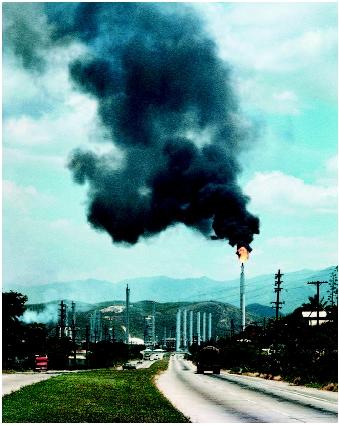
Environmental Pollution
Petroleum-derived contaminants constitute one of the most prevalent sources of environmental degradation in the industrialized world. In large concentrations, the hydrocarbon molecules that make up crude oil and petroleum products are highly toxic to many organisms, including humans. Petroleum also contains trace amounts of sulfur and nitrogen compounds, which are dangerous by themselves and can react with the environment to produce secondary poisonous chemicals. The dominance of petroleum products in the United States and the world economy creates the conditions for distributing large amounts of these toxins into populated areas and ecosystems around the globe.
Smoke is pouring from a refinery burnoff vent. (
© Royalty-Free/Corbis. Reproduced by permission.)
Oil Spills
Perhaps the most visible source of petroleum pollution are the catastrophic oil-tanker spills—like the 1989 Exxon Valdez spill in Prince William Sound, Alaska—that make news headlines and provide disheartening pictures of oilcoated shorelines and dead or oiled birds and sea animals. These spills occur during the transportation of crude oil from exporting to importing nations. Crude oil travels for long distances by either ocean tanker or land pipeline, and both methods are prone to accidents. Oil may also spill at the site where it is extracted, as in the case of a blowout like the Ixtoc I exploratory well in 1979 (see table "Ten Largest Oil Spills in History"). A blowout is one of the major risks of drilling for oil. It occurs when gas trapped inside the deposit is at such a high pressure that oil suddenly erupts out of the drill shaft in a geyser.
Accidents with tankers, pipelines, and oil wells release massive quantities of petroleum into land and marine ecosystems in a concentrated form. The ecological impacts of large spills like these have only been studied for a very
World Oil Price 1970-2000 (
World Oil Market and Price Chronologies DOE Energy Information Administration; originally published by the Department of Energy's Office of the Strategic Petroleum Reserve, Analysis Division) few cases, and it is not possible to say which have been the most environmentally damaging accidents in history. A large oil spill in the open ocean may do less harm to marine organisms than a small spill near the shore. The Exxon Valdez disaster created a huge ecological disaster not because of the volume of oil spilled (eleven million gallons) but because of the amount of shoreline affected, the sensitivity and abundance of organisms in the area, and the physical characteristics of the Prince William Sound, which helped to amplify the damage. The Exxon Valdez spill sparked the most comprehensive and costly cleanup effort ever attempted, and called more public attention to oil accidents than ever before. Scientific studies of the effects of oil in Prince William Sound are ongoing, and the number of tanker accidents worldwide has decreased significantly since the time of the Valdez spill, due to stricter regulations and such required improvements in vessel design as double-hull construction.
Petroleum-derived contaminants constitute one of the most prevalent sources of environmental degradation in the industrialized world. In large concentrations, the hydrocarbon molecules that make up crude oil and petroleum products are highly toxic to many organisms, including humans. Petroleum also contains trace amounts of sulfur and nitrogen compounds, which are dangerous by themselves and can react with the environment to produce secondary poisonous chemicals. The dominance of petroleum products in the United States and the world economy creates the conditions for distributing large amounts of these toxins into populated areas and ecosystems around the globe.
Smoke is pouring from a refinery burnoff vent. (
© Royalty-Free/Corbis. Reproduced by permission.)
Oil Spills
Perhaps the most visible source of petroleum pollution are the catastrophic oil-tanker spills—like the 1989 Exxon Valdez spill in Prince William Sound, Alaska—that make news headlines and provide disheartening pictures of oilcoated shorelines and dead or oiled birds and sea animals. These spills occur during the transportation of crude oil from exporting to importing nations. Crude oil travels for long distances by either ocean tanker or land pipeline, and both methods are prone to accidents. Oil may also spill at the site where it is extracted, as in the case of a blowout like the Ixtoc I exploratory well in 1979 (see table "Ten Largest Oil Spills in History"). A blowout is one of the major risks of drilling for oil. It occurs when gas trapped inside the deposit is at such a high pressure that oil suddenly erupts out of the drill shaft in a geyser.
Accidents with tankers, pipelines, and oil wells release massive quantities of petroleum into land and marine ecosystems in a concentrated form. The ecological impacts of large spills like these have only been studied for a very
World Oil Price 1970-2000 (
World Oil Market and Price Chronologies DOE Energy Information Administration; originally published by the Department of Energy's Office of the Strategic Petroleum Reserve, Analysis Division) few cases, and it is not possible to say which have been the most environmentally damaging accidents in history. A large oil spill in the open ocean may do less harm to marine organisms than a small spill near the shore. The Exxon Valdez disaster created a huge ecological disaster not because of the volume of oil spilled (eleven million gallons) but because of the amount of shoreline affected, the sensitivity and abundance of organisms in the area, and the physical characteristics of the Prince William Sound, which helped to amplify the damage. The Exxon Valdez spill sparked the most comprehensive and costly cleanup effort ever attempted, and called more public attention to oil accidents than ever before. Scientific studies of the effects of oil in Prince William Sound are ongoing, and the number of tanker accidents worldwide has decreased significantly since the time of the Valdez spill, due to stricter regulations and such required improvements in vessel design as double-hull construction.
Thanks
ReplyDeleteS.W.E.D.
ReplyDelete